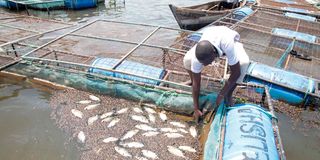Farmers lost about Sh1 billion to fish kills in Lake Victoria, report says

A fisherman collects dead fish from fish cages in Lake Victoria on October 20, 2022. Fish kills has affected a total of 135 cage farmers in 10 beaches along the lake.
The government has recommended the decommissioning or transfer of illegal cages in Lake Victoria following sporadic fish kills – die-off of fish populations – estimated to have cost fish farmers close to Sh1 billion.
The phenomenon that affected Kisumu and Homa Bay counties affected a total of 135 cage farmers in 10 beaches along the lake.
According to the report by a multi-agency team that assessed the possible causes of fish kills, Kisumu suffered the hugest loss of Sh884.8 million while Homa Bay incurred a loss of Sh43 million.
The team proposed that both the national and county government departments responsible for fisheries should provide an economic stimulus package to affected farmers.
The 17-member taskforce supervised by State Department for the Blue Economy and Fisheries Principal Secretary Betsy Njagi, noted that highest losses were experienced by Kentila Farms and Lake Aqua Ltd at Sh200.4 million and Sh138 million respectively both of which are in Ogal beach in Kisumu County.
“There is growing concern that the proliferation of fish cages in Lake Victoria may have significant consequences on the lake’s ecology,” said the report in part.
Installation of cages in the lake has significantly expanded from 1663 in 2016 to over 5,500 cages presently.
Out of the 135 affected cage farmers, only 14 had National Environment Management Authority (NEMA) license, particularly in Ogal beach in Kisumu County.
Homa Bay County had concession with the beach Management Units (BMU) while other licenses by regulatory bodies such as Kenya Fisheries and the National Land Commission (NLC) were lacking in both counties.
“The lack of statutory requirements by such bodies makes it difficult to determine the efficacy of management to address such threats,” noted the document submitted to Cabinet Secretary Salim Mvurya.
The committee further explored compensation options to be included in the regulations by ensuring that cage farmers insure their business as part of the licensing requirement.
The incident that happened between September to November 2022 affected a total of 747 cages which were mainly installed in shallow zones in the gulf (less than 10 metres). This has contributed to minimal cases of water circulation and confined cultured fish with no room to escape.
Among other causes of fish kills, the taskforce established that Lake Victoria experienced an increased amount of organic matter that is undergoing decomposition and utilizing dissolve oxygen, hence reducing oxygen in the water to very low levels.
“The increased organic matter is originating from the lake itself (such as water hyacinth and other water plants) and from land sources such as fertilisers from agricultural farms and river discharges,” noted the report.
On the other hand, high temperature levels of up to 26 degrees celsius further speeded up the decomposition of organic matter.
As a way forward, the taskforce recommended creation of awareness and sensitization and rapid continuous periodical monitoring and surveillance on point source of pollution in the lake.
They further underlined the need to dredge the Mbita causeway to its original depth of about 10 to 12 metres.
In order to preserve uncompromised dead fish, the taskforce stated that cold chain facilities should be set up at strategic beaches.





